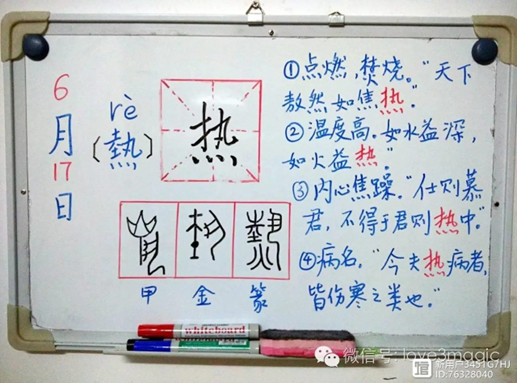博文
【热 thermal】中英文词源比较
||
theory of relationship between heat and mechanical energy, 1854, from thermodynamic (adj.); also see -ics. "The consideration of moving forces, though suggested by the form of the word, does not enter into the subject to any considerable extent" [Century Dictionary].
dynamic[dynamic 词源字典]
dynamic: [19] Greek dūnamis (a word of unknown origin) meant ‘strength’. It was used by the Swedish chemist Alfred Nobel in 1867 to form the name of the new explosive he had invented, dynamite. From it was derived the adjective dunamikós ‘powerful’, which French adopted in the 17th century as dynamique, and English acquired it in the early 19th century. Related to dúnamis was the verb dúnasthai ‘be strong’ or ‘be able’; from this was derived the noun dunasteíā ‘power, domination’, source, via French or late Latin, of English dynasty [15].
thermal (adj.)[thermal 词源字典]
1756, "having to do with hot springs," from French thermal (Buffon), from Greek therme "heat, feverish heat," from PIE *gwher- "to heat, warm" (cognates: Latin fornax "an oven, kiln," formus "warm," Old English wearm; see warm (adj.)). Sense of "having to do with heat" is first recorded 1837. The noun meaning "rising current of relatively warm air" is recorded from 1933.[t
heat: [OE] From an etymological point of view, heat is simply ‘hotness’ – that is, the adjective hot with an abstract noun suffix added to it. But the addition took place a long time ago, in the prehistoric ancestor of Old English. The suffix *-īn ‘state, condition’ was tacked on to the adjective *khaitaz ‘hot’ to produce *khaitīn, which eventually became modern English heat. The verb heat is equally ancient, and was independently formed from *khiataz (het, as in ‘het up’, comes from a dialectal form of its past participle).
=> het, hot[
小结:在英国,来自1756年希腊语的thermal ,比来自古英语的heat,要显得高雅、正规并受到重视。
《热》字义,《热》字的字形演变,小篆隶书楷书写法《热》

“热”是象形字。甲骨文像一个人手举火把之形,表示点燃火把。小篆另加义符“火”。隶变后楷书写作“熱”。汉字简化后写作“热”。
注:甲骨文是商朝(约公元前17世纪-公元前11世纪)的文化产物,距今约3600多年的历史。
《说文·火部》:“熱,温也。从火,埶声。”(熱,温暖。从火,埶声。)
“热”的本义是点燃火把。泛指烧。甲骨卜辞中多次出现“爇田”一词,意思是点燃火炬以驱赶野兽,准备猎取。进而引申指温度高。如《孟子·梁惠王下》:“如水益深,如火益热。”
引申指情意浓烈深厚。如“热爱”、“热情”。又引申指很受人关注或欢迎的。如“热门”、“热门货”。
https://m.pinshiwen.com/yuexie/shuojie/20200802281957.html

http://www.bdzzz.com/bd/ziyuan/9/UFxDSkM-.html

http://www.360doc.com/content/21/0723/13/76328040_987865314.shtml
https://blog.sciencenet.cn/blog-504669-1356593.html
上一篇:丘成桐:中国一定要成为数学强国 9月22日晚7点直播
下一篇:大国的标志是有能力打赢战争